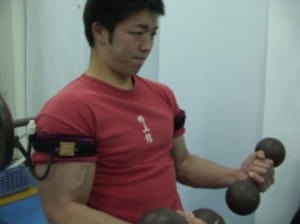Questo articolo mi sembra degno di segnalazione!
Eagle
Clin Physiol Funct Imaging. 2010 Sep;30(5):338-43. Epub 2010 Jul 4.
Effects of low-intensity bench press training with restricted arm muscle blood flow on chest muscle hypertrophy: a pilot study.
Yasuda T, Fujita S, Ogasawara R, Sato Y, Abe T.
Graduate School of Frontier Sciences, The University of Tokyo, Kashiwa, Chiba, Japan. yasuda@h.k.u-tokyo.ac.jp
Abstract
Single-joint resistance training with blood flow restriction (BFR) results in significant increases in arm or leg muscle size and single-joint strength. However, the effect of multijoint BFR training on both blood flow restricted limb and non-restricted trunk muscles remain poorly understood. To examine the impact of BFR bench press training on hypertrophic response to non-restricted (chest) and restricted (upper-arm) muscles and multi-joint strength, 10 young men were randomly divided into either BFR training (BFR-T) or non-BFR training (CON-T) groups. They performed 30% of one repetition maximal (1-RM) bench press exercise (four sets, total 75 reps) twice daily, 6 days week(-1) for 2 weeks. During the exercise session, subjects in the BFR-T group placed elastic cuffs proximally on both arms, with incremental increases in external compression starting at 100 mmHg and ending at 160 mmHg. Before and after the training, triceps brachii and pectoralis major muscle thickness (MTH), bench press 1-RM and serum anabolic hormones were measured. Two weeks of training led to a significant increase (P<0.05) in 1-RM bench press strength in BFR-T (6%) but not in CON-T (-2%). Triceps and pectoralis major MTH increased 8% and 16% (P<0.01), respectively, in BFR-T, but not in CON-T (-1% and 2%, respectively). There were no changes in baseline concentrations of anabolic hormones in either group. These results suggest that BFR bench press training leads to significant increases in muscle size for upper arm and chest muscles and 1-RM strength.
Eagle
Clin Physiol Funct Imaging. 2010 Sep;30(5):338-43. Epub 2010 Jul 4.
Effects of low-intensity bench press training with restricted arm muscle blood flow on chest muscle hypertrophy: a pilot study.
Yasuda T, Fujita S, Ogasawara R, Sato Y, Abe T.
Graduate School of Frontier Sciences, The University of Tokyo, Kashiwa, Chiba, Japan. yasuda@h.k.u-tokyo.ac.jp
Abstract
Single-joint resistance training with blood flow restriction (BFR) results in significant increases in arm or leg muscle size and single-joint strength. However, the effect of multijoint BFR training on both blood flow restricted limb and non-restricted trunk muscles remain poorly understood. To examine the impact of BFR bench press training on hypertrophic response to non-restricted (chest) and restricted (upper-arm) muscles and multi-joint strength, 10 young men were randomly divided into either BFR training (BFR-T) or non-BFR training (CON-T) groups. They performed 30% of one repetition maximal (1-RM) bench press exercise (four sets, total 75 reps) twice daily, 6 days week(-1) for 2 weeks. During the exercise session, subjects in the BFR-T group placed elastic cuffs proximally on both arms, with incremental increases in external compression starting at 100 mmHg and ending at 160 mmHg. Before and after the training, triceps brachii and pectoralis major muscle thickness (MTH), bench press 1-RM and serum anabolic hormones were measured. Two weeks of training led to a significant increase (P<0.05) in 1-RM bench press strength in BFR-T (6%) but not in CON-T (-2%). Triceps and pectoralis major MTH increased 8% and 16% (P<0.01), respectively, in BFR-T, but not in CON-T (-1% and 2%, respectively). There were no changes in baseline concentrations of anabolic hormones in either group. These results suggest that BFR bench press training leads to significant increases in muscle size for upper arm and chest muscles and 1-RM strength.

Commenta